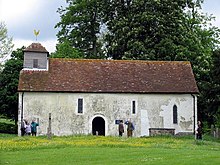Church in Hampshire, England
| All Saints Church, Little Somborne | |
|---|---|
 All Saints' Church, Little Somborne, from the south All Saints' Church, Little Somborne, from the south | |
 | |
| 51°05′31″N 1°27′21″W / 51.0919°N 1.4557°W / 51.0919; -1.4557 | |
| OS grid reference | SU 383 326 |
| Location | Little Somborne, Hampshire |
| Country | England |
| Denomination | Church of England |
| Website | Churches Conservation Trust |
| Architecture | |
| Functional status | Redundant |
| Heritage designation | Grade II* |
| Designated | 29 May 1957 |
| Architectural type | Church |
| Style | Anglo-Saxon, Norman |
| Specifications | |
| Materials | Rendered flint rubble with stone dressings Tiled roof |
All Saints' Church is a redundant Church of England parish church in the hamlet of Little Somborne, Hampshire, England. It is a Grade II* listed building in the National Heritage List for England and is under the care of the Churches Conservation Trust. The church is about 4 miles (6 km) southeast of Stockbridge, east of the A3057 road.
History
The oldest parts of the church are Anglo-Saxon. It is recorded in the Domesday Book. The original church had a nave and a chancel, but in 1170 the chancel was removed, the nave was extended towards the east, and a very small chancel was added at the east end. The chancel was removed in the 17th century, the chancel arch was filled in with a wall and a window was inserted.
Architecture
The church is built of flint rubble with stone dressings. The walls are rendered and colourwashed. The roof is tiled. Its plan is simple, consisting of a nave and a chancel in a single range, with a weatherboarded bellcote at the west end. At the east end, within the former chancel arch, is a three-light square-headed window, and above this are two lancet windows. In the north wall of the chancel is a 12th-century single-light window. West of this is a blocked door dating from the same period. Also in the north wall is an Anglo-Saxon pilaster strip made in Binstead stone from the Isle of Wight. In the south wall of the chancel is a 13th-century lancet window. West of this are two single-light square-headed windows. Between these is a Norman round-headed doorway. The west window is 14th-century and has two lights with trefoil heads, and there is a quatrefoil window above it.
The plaster has been stripped from the interior side of the walls, and the floor has been partly removed and replaced by flagstones. South of the chancel arch is a small round-headed niche. The font is 19th-century.
Churchyard
In the churchyard is the grave of Thomas Sopwith (1888–1989), the pioneer aviator, aircraft manufacturer and yachtsman.
See also
References
- ^ Historic England, "Church of All Saints (Grade II*) (1167714)", National Heritage List for England, retrieved 27 June 2013
- ^ All Saints' Church, Little Somborne, Hampshire, Churches Conservation Trust, retrieved 25 March 2011
- Little Somborne, Streetmap, retrieved 22 March 2011
- Page, William, ed. (1911). "Little Somborne". A History of Hampshire and the Isle of Wight. Victoria County History. Vol. IV. London: Archibald Constable & Co. pp. 480–482. ISBN 978-0712905947 – via British History Online.
External links
- Meehan, Barry (27 January 2014). "All Saints, Little Somborne". Hampshire Churches. Archived from the original on 27 January 2014. – detailed architectural description
- "Little Somborne, Hampshire – All Saints Church". Astoft. – photographs of the exterior and interior
- Vigar, John. "All Saints Little Somborne". Hampshire Churches. – photographs
- 11th-century church buildings in England
- Church of England church buildings in Hampshire
- Churches with elements of Anglo-Saxon work
- Churches preserved by the Churches Conservation Trust
- English churches with Norman architecture
- Former Church of England church buildings
- Grade II* listed churches in Hampshire